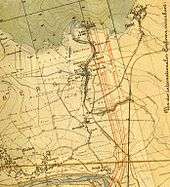Rhine Regulation
The Regulation of the Rhine (German: Rheinregulierung) or Rhine Correction (Rheinkorrektion), refers to the canalisation of the Alpine Rhine on the border between Austria and Switzerland in the early 20th century. Its aim was to reduce the risk of flooding and to re-route the international border which ran along the old course of the Rhine.
History
The oldest record of flooding on the Alpine Rhine dates to 1206. One of the worst instances took place on 28 September 1868, when almost the whole of the Rhine valley from Sevelen to Lake Constance stood under water. The embankment broke at three points. The Alpine Rhine meandered through the Alpine Rhine Valley in a riverbed 200 to 300 metres wide, accompanied on both sides by inland waters and embankments 500 to 1,000 metres apart. From 1861 to 1881, the Canton of St. Gallen, supported by the Swiss Federal Treasury, the Principality of Liechtenstein and the Austrian Empire, created a regular riverbed between Landquart and Au. However, the capacity of the river bed was still insufficient, which is why the embankments were raised again by 1890.[1]
More than 30 streams still flowed into the Alpine Rhine below Landquart. At high water these were filled up and flooded. As a result, the 20.8 km long Werdenberg Canal was built in less than two years, from 1882 to 1884, collecting all the tributaries between Wartau and Rüthi and feeding their waters into the Rhine. Twenty years later the Rhine Valley Canal was opened, collecting all the streams from Rüthi to Au. In 1910, the Vorarlberg Rhine Valley Canal was completed, which drained the area between the catchments of the Frutz and Dornbirner Ach.[2] The Liechtenstein Canal, just under 25 km long, was not finished until 1943.[3]
1892 Treaty

The 1892 treaty between Austria-Hungary and Switzerland on the regulation of the Rhine[4] put to an end the many flood disasters on the Alpine Rhine between Sargans and Lake Constance, reducing the course of the river by means of two cuts in order to increase the gradient, raise the flow rate of the river and prevent deposition of sediments. The company, Internationale Rheinregulierung (IRR) is the umbrella under which the two countries, Austria and Switzerland, coordinated the construction and they still maintain the banks today. They have their head office in Rorschach, Switzerland, and a construction department in Austrian Lustenau and Swiss St. Gallen.
References
- Erziehungsrat des Kanton St. Gallen, ed. (1982), "Der Rhein wird gebannt", St.Gallerland (in German), Kantonaler Lehrmittelverlag St.Gallen, pp. 256 ff
- Erziehungsrat des Kanton St. Gallen, ed. (1982), "Der Bau der Binnenkanäle", St.Gallerland (in German), Kantonaler Lehrmittelverlag St.Gallen, pp. 258, 259
- Haidvogel, Gertrud, Projektleiter: Brunhart, Arthur (ed.), "Stichwort „Binnenkanal"", Historisches Lexikon des Fürstentums Liechtenstein (in German), Zürich: Chronos, Band 1, p. 101
- SR 0.721.191.631
Literature
- Internationale Rheinregulierung (publ.): Der Alpenrhein und seine Regulierung. Internationale Rheinregulierung 1892–1992. 2nd edn., BuchsDruck, Rorschach, 1993, ISBN 3-905222-65-5.
External links
- Homepage of the IRR
- Internationale Rheinregulierung in Vorarlberg: Allgemeine Bauzeitung, year 1900, p. 90 (Online bei ANNO)
- Swisstopo, topografische Zeitreise von 1850 bis heute